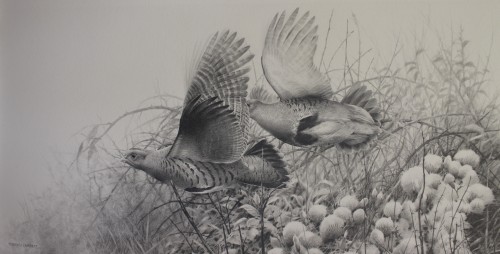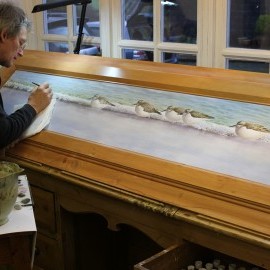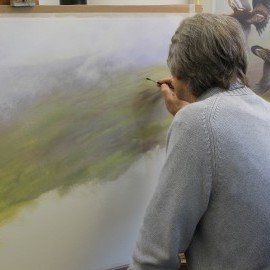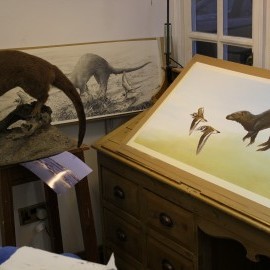On the Easel
Optional subheading
I am going to attempt to show the creation of a work from start to finish. It will obviously work well when I am developing a larger piece but smaller studies will also be included. I will endeavour to update this regularly….... so watch this space!
Contact - Message Sent
Thank you for your message
Your email has been successfully sent.
Artist Profile
Over three decades ago The Times of London heralded Terence Lambert’s arrival on the wildlife art’s stage with: “Terence Lambert must stand as one of the finest imaginative bird painters alive today. His illustrative technique alone is remarkable, his fastidious eye for the details of plumage and perch. Yet it is his ability to enter a birds universe, his intuitive sense of the intensity of its life that sets him apart. Still driven today to master the complexities of pen pencil and paint, he can justly be described as a key player in the development of contemporary wildlife art”.
Art
Galleries
Gallery one shows the work that is currently for sale. Galleries two and three are retrospective collections of works that have sold in the last decade. Limited edition prints can be viewed in gallery four.
Contact
Email: terencelambert@btinternet.com
Telephone: 01650 521 420
Or write to me at:
Hafod-y-llan,
Llan,
Llanbrynmair,
Powys
SY19 7DW
UK
Bibliography
Bibliography
- ‘Collins British Birds’. John Gooders and Terence Lambert. 249 Colour and 65 Black & White Illustration. 1982. Reprint 1987 and 1995 with a new dust wrapper.
- ‘Lambert’s Birds of Shore and Estuary’. Collins. 58 Colour & 8 Black & White Illustrations. 1979.
- ‘Lambert’s Birds of Garden and Woodland’. Collins. Printed in 6 languages and a U.S.A. edition. 64 Colour Illustrations. 1976
Books and Booklets illustrated in whole, or in part
The Birds of Gloucestershire’ by Gordon Kirk & John Phillips. Liverpool University Press. Coloured dust jacket and 24 b/w illustrations 2013
‘The Outing’ article by graham Coley & Terence Lambert in the Piscatorial society journal number 128. b/w illustration. 2012
‘Golden Days’ Romilly Fedden. Coch y Bonddu Books. Coloured jacket 2012
Field sports Magazine. ‘An Appreciation of his Art’ 6 page feature including 6 coloured illustrations and a studio photo of the artist. 2010
‘Countrywise’ The language of the countryside. Paul Walkden & John Dryden. Witchwood Lodge Press. 21 b/w illustrations. 2009
Extracts from a field study diary. Red Kites of the British Isles. 1979-1990. Sir Michael Leighton,Bt. published by the author. 100 copies 10 sepia illustrations. 2008
‘Redbreast’ the Robin in Life & Literature’. Andrew Lack. SMH Books. Coloured dust jacket. 2008
‘The Grouse - an Artists Impressions’. 9 coloured plates & 3 black & white and one sepia illustration. Swan Hill Press. 2007
- ‘The Woodcock. Artists’ Impressions.’ Swan Hill. 9 colour, 3 black and white. 2006.
- ‘The Loch Fisher’s Bible’. Stan Headley. 14 black and white illustrations. Hale Publishers 2005.
- George Forrest, Plant Hunter. Brenda McLean. 2 coloured plates. Antique Collectors Club in association with the Royal Botanic Garden, Edinburgh. 2004.
- Dursley Birdwatching and Preservation Society. ‘50th Anniversary year exhibition Catalogue’. 2003. 1 Black & White Illustration of Wren. Used extensively on all Catalogues, Posters, Flyers and Labels during the Celebrations in 2003.
- ‘Wildfowl & Wetlands Trust Members Magazine’. Cover Illustration of Redshank. Summer edition 2001.
- Lintukartta Suomen Pesimalinnut. ‘A Domino Bird Chart’. Domino Books Ltd. 2001. (Original design by Hermann Heinzel and Illustrated by Terence Lambert in 1979).
- ‘Conservation, Access and Recreation, an overview 1999-2000’. Colour Cover. Welsh Water Annual Report. August July 2000.
- ‘Game Conservancy Trust Scottish Fair’, Scone, Perth. Colour Cover for fair Programme. 2000.
- ‘Conservation, Access and Recreation, an overview 1998-99’. Colour Cover. Welsh Water Annual Report. August 1999.
- ‘The Wetland Bird Survey 1996-97’. Coloured Cover. B.T.O., W.W.T, R.S.P.B, J.N.C.C. 1999.
- ‘Conservation, Access and Recreation, an overview 1997-98’. Colour Cover. Welsh Water Annual Report. August 1998.
- ‘Vultures are Bald - I Wonder Why Series’. Amanda O’Neill. 5 Colour Illustrations and Cover. Kingfisher Books. 1997.
- ‘The Gamekeepers Auction Catalogue’. Colour Cover. The Gamekeepers Welfare Trust. B.A.S.C. 1997.
- ‘Conservation, Access and Recreation, an overview 1996-97’. Colour Cover. Welsh Water Annual Report. August 1997.
- ‘Childrens First Encyclopedia’. Sue Barraclough, C Evans & D Fox, (editors). Colour Dustwrapper repeated inside and a further 5 Colour illustrations, 1 repeated on contents page. Kingfisher Books. 1996.
- ‘Gloucestershire Wildfowlers Association 40th Anniversary Handbook and Rules’. Paul Walkden, (editor). 8 Black & White illustrations. G.W.A. 1996.
- ‘Lessons from the Fish: An Anthology of Fishing Experiences’. Written by National Celebrities, Selected and Edited by Len Colclough. Colour Dustwrapper and 20 Black & White illustrations. Swan Hill Press. 1996.
- ‘Conservation, Access and Recreation, an overview 1995-96’. Colour Cover. Welsh Water Annual Report. August 1996.
- ‘The Dodo is Dead - I Wonder Why Series’. Andrew Charman. 1 Colour Plate. Kingfisher Books. 1996.
- ‘Wild Technology’. Phil Gates. Colour Dustwrapper Illustration. Kingfisher Books. 1995. ‘
- ‘An Exaltation of Skylarks’. Stewart Beer. Colour Dustwrapper Illustration. SMH Books. Sussex. 1995.
- ‘Kingfisher Field Guide to the Birds of Britain and Ireland’. John Gooders. Dustwrapper illustration of Nuthatch, (not attributed to artist). Kingfisher Books. Reprint 1994.
- ‘Birds In Wales’. Roger Lovegrove, Williams & Williams. 13 Black & White Illustrations. Poyser. 1994.
- ‘Trout Flies of Wales’. Moc Morgan. 1 Black & White plate. Gomer Press. Revised edition 1993.
- ‘Dinosaurs, Young World’. Camilla Halliman, (editor). 22 Colour Illustrations. Kingfisher Books. 1993.
- ‘All Kinds of Animals, Young World’. Camilla Halliman, (editor). 43 Colour Illustrations. Kingfisher Books. 1992.
- ‘Kingfisher Field Guide to the Birds of Britain and Europe’. John Gooders. Colour dustwrapper illustration. Different from 1st edition see 1990. Kingfisher Books. 1993.
- ‘A Companion to British Wildlife’. 18 Colour Illustrations. Marshall Cavendish. 1992.
- ‘Wildlife Fact File Yearbook 1992’. Sydney Francis, (editor). Article on Terence Lambert complete with Colour Illustrations. 1991.
- ‘Wildlife Fact File’. Sydney Francis, (editor). 110 Colour illustration cards building to a 7 volume set. International Masters Publishers Ltd. 1991.
- ‘Angling in Art’. Tom Quinn. 1 Colour plate. Sportsman’s Press. 1991. Permission was not sought from the artist prior to publication!
- ‘Nature in Art’. David Trapnell. 1 Colour and 1 preliminary drawing reproduced in Black & White. David and Charles. 1991.
- ‘The Birdwatchers Year’. Malcolm Greenhalgh. 12 Black & White Plates. Chancellor Press. 1990. second edition 1993.
- ‘Kingfisher Field Guide to the Birds of Britain and Europe’. John Gooders. Colour dustwrapper, front and back. Kingfisher Books. 1990.
- ‘Fishing in Wild Places’. David Street. Colour Frontispiece and 24 Black & White illustration, 1 repeated on endpapers. Golden Grove, Llandysul. 1989. Reprinted by H.F & G. Witherby in 1990 and Penguin Books in 1995.
- ‘Mid Wales Companion’. Moira K Stone. 2 Black & White Illustration. Antony Nelson. 1989.
- ‘The Nature of Central Wales’. Fred Slater. Colour Frontispiece repeated on dustwrapper. Also 2 Black & White illustrations. Barracuda books. Buckingham. 1988.
- ‘A companion to the British Countryside’. Various contributors. 6 double page colour spreads. W.H. Smith Exclusive books. 1989. Previously used in The Country Companion by David Buxton. Marshall Cavendish 1986.
- ‘The Complete Birdwatchers Guide’. John Gooders. 23 Colour and 15 Black & White Illustrations. Kingfisher Books. 1988, reprinted 1989 and 1992.
- ‘The Royal Society for the Protection of Birds, Countryside Diary 1987’. Nigel Sitwell, (editor). 4 Colour plates. R.S.P.B. 1986.
- ‘The Country Companion’. David Buxton, (editor). Weekly Magazine building into a 7 volume work. Marshall Cavendish. 1986.
- ‘Birds of Rivers, Lakes and Streams’. Fred Milton, (editor). Colour dustwrapper and 12 Colour Plates. Marshall Cavendish. 1985.
- ‘Bird Watch’. John Gooders, (editor). Weekly magazine building into a 2 volume work. Marshall Cavendish. 1983.
- ‘The Easy Way to Bird Recognition’. John Kilbracken. Coloured dustwrapper illustration. Kingfisher Books. 1982.
- ‘The Living Bird’ . 18th annual report of Comell laboratory of Ornithology, 1979 - 1980. Douglas Lancaster (Editor). 2 Colour plates. Comell University. 1980.
- ‘The Domino Guide to the Bird table’. Hermann Heinzel. Folded booklet. Fontana Books. 1979.
- ‘Sea Shells of the West Indies’. Coloured dustwrapper illustration. Collins. 1977.
OTHER WORKS
2004 The Welsh Kite Trust. Christmas Card, ‘Kite over Conifers’. Available in 2 formats.
2004 The Game Conservancy Trust. Wildlife Art Calendar 2005.
2003 The Game Conservancy Trust. Wildlife Art Calendar 2004. 8 images. (3 Artists).
2003 The Welsh Kite Trust. Notelets. Pencil Red Kite image.
2002 The Game Conservancy Trust. Wildlife Art Calendar 2003. 8 images. (3 Artists).
2000 B.A.S.C. Wildlife Art Calendar. 3 images. May, June & December. 3000 printed.
2000 B.A.S.C. Christmas Card. ‘Turtles’ 30,000 printed.
1999 The Mayor of Llanidloes. Christmas Card. Red Kites.
1999 The Welsh Kite Trust. Christmas Card. ‘Kites at Dawn’. 6,000 printed.
1999 B.A.S.C. Christmas Card. ‘Winter Greys’ 30,000 printed. Sold Out.
1995 B.A.S.C. Christmas Card. ‘Blackcock at Lek’ 30,000 printed. Sold Out.
1994 United Kingdom Habitat Stamp. The Wildlife Habitat Trust.
1993 Flowers of Portugal. 12 Ceramic Plates. Mark Jones Studio.
1991 Badge for Hamdden Country Sports. (Welsh Water) Design of Woodcock.
1989 Calendar: Lambert’s Exotica. 6 Colour plates and 6 Pencil drawings. Lockwards.
1988 Calendar: Pheasants of the World. 6 Colour plates and 6 Pencil drawings. Lockwards.
1982 -1995 Annual Calendar with 12 Coloured plates from Collins British Birds by John Gooders.
1981 The Garden Bird Bells. 12 English Bone China Bells. Royal Doulton, Franklin Porcelain.
1978 Agriframes Company Christmas Card. Redwing & Fieldfare. (Plate from Lambert’s Birds of Garden and Woodland).
We acknowledge with thanks the work of Paul Walkden in compiling this bibliography.
Biography and Reviews
A PERSONAL Perspective

Lying belly down on the floor scratching with a pencil on any surface I could find was as much part of my childhood as jumpers for goal posts and scabby knees. The Surrey countryside was my playground. My countryman father was my guide. Before my teens I could put names to most of the birds I encountered. Like all children before me, I collected everything nature had discarded, feathers, bones, butterflies and eggs, all lovingly catalogued in scrapbooks and shoeboxes, and stashed under the bed.
Through my frequent solitary rambles I witnessed the harshness and reality of predator and prey encounters, that later occurred in many of my paintings. I joined the predator pack. Armed with a fishing rod, I pursued every species that swam in the lakes and rivers within bicycle distance from home. It was there I judged the weight of a Kingfisher that used my hand-held cane as a platform to plunge at fry, nipping at the discarded bread crusts floating under my rod. Daily visits eventually led to all-night expeditions. There were times when these extended into whole weeks away from home, having a negative effect on more academic studies. But it was opening my young eyes to many of nature’s secrets, feeding my appetite for new experiences.
With a career as my priority, I spent four years at Guildford School of Art, studying Product Design. Although never employed in the field, it taught me self-discipline and an attention to detail, qualities that have helped in my desire to master the painting craft. The ability to draw with confidence and accuracy is the great liberator allowing the artist’s observation and imagination freedom to create unique images.
So often painters are categorized because of a favoured medium or subject. I have painted birds almost exclusively for 30 years, illustrating the British list three times for various publications, together with a host of foreign species. So it’s hardly surprising that I have been posted in the bird painter’s pigeonhole. When the illustrator’s hat is put on the stand and the Artists ‘Berrie’ is cocked at a jaunty angle, then the pigeonhole can be emptied. After the inspiration of observation in the field, I try to create paintings that are more than just accurately crafted. I hope to show the subject to possess a personality, not any buzzard, but a particular buzzard, that exists beyond the confines of the chosen rectangle. The plants and the props that are part of the painting are not wasted marks of suggestion but are accurate in texture, form and scale.
I am not interested in the accidents made with a chosen pigment. For the last ten years I have worked with both oil and chroma colour (Acrylic) on gessoed canvas. These paintings have given me the greatest freedom, allowing me to boldly cover the whole surface before tackling any detailed work.
These works have freed me from my illustrator’s mind-set, an attitude that said detail was everything. Detail alone does not make a successful painting. Further challenges have come by painting with ink on white scraperboard, working with dilute ink washes and painting from light to dark using a scalpel to scratch into the chalk surface, attempting to recreate the textures of plant and feather. This technique is the finest and most painstaking I undertake. I work on the inks during the mornings because I now find it difficult to focus on the fine point of a scalpel all day.
Exchanging ideas with other painters has been a very important part of my development. Spending a week each year in Gloucestershire at Nature in Art, The national collection of art inspired by nature, has given me valuable opportunities to meet with fellow artists. These exchanges, together with teaching, are opportunities to review methods and ideas and prevent one from becoming formulaic. I have both worked and taught at the museum with Richard Smith, a uniquely extrovert painter who I have unashamedly drained of ideas and techniques since we first met in the late eighties.
Artists are a privileged breed, with many being able to choose where they live and work. For some there are opportunities to travel. I have had the good fortune to have been commissioned on projects that have taken me to some of the world’s most exciting countries. In 1984, while working with The World Pheasant Association, I spent two months in spring and autumn in the Himalayas. climbing to eighteen thousand feet and looking up to the awesome summit of Mt. Everest eleven thousand feet above me. In the same year I walked the deserts of Oman, studying and sketching many desert species while researching a project commissioned by Shell Oil Company. These paintings were given as a gift to the Sultan of Oman and were to become Shell’s 1988 calendar. Although these experiences have influenced many paintings, the core of my output has come as a result of choosing to live in Wales. The diversity of the Mid-Wales landscape is so very unique. Within a thirty minute drive from my studio, I have access to coast and estuary, mountain and moorland and some of the most beautiful river valleys in the whole of the British Isles, all of which are an endless supply of inspiration to me.
Home
The WIldlife Art of Terence Lambert
I have curated an exhibition for MOMA Machynlleth it will include works by Kim Atkinson,Terence Lambert, Darren Rees, Phillip Snow and Owen Williams the show runs from the opening on 29th September until 24th November.


